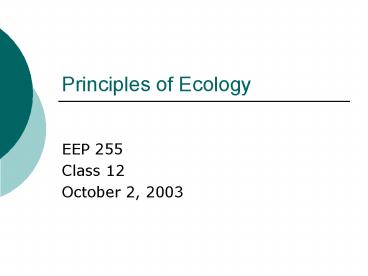Principles of Ecology - PowerPoint PPT Presentation
1 / 21
Title:
Principles of Ecology
Description:
Ecology can be defined as the study of relationships between organisms and the environment ... Polar ice 7.5 million Km3. Surface water = 3 million Km3. Flows /yr ... – PowerPoint PPT presentation
Number of Views:20
Avg rating:3.0/5.0
Title: Principles of Ecology
1
Principles of Ecology
- EEP 255
- Class 12
- October 2, 2003
2
What is Ecology?
- Ecology can be defined as the study of
relationships between organisms and the
environment - Ecologists study these relationships over a large
range of temporal and spatial scales and using a
variety of approaches. - Scales
- Individual organisms,
- Populations
- Communities
- Ecosystems (biotic abiotic)
- Biomes
- Global
3
Environmental Factors
- Soil quality
- Water quality
- Air quality
- Temperature
- Energy
- Nutrients
- Chemicals
- Variations, sensitivity, resilience, robustness,
dynamics
4
Dimensions
- Population distribution and abundance
- Population dynamics
- Food webs
- Competition and mutualism between organisms
- Ecosystem functions
- Energy cycles
- Bio-geochemical cycles
5
Ecosystem Functions
- Ecosystem functions transform the quality or
spatial location of matter and energy (similar to
economic production functions). - Photosynthesis solar energy capture and biomass
production - Food Chain or Web chemical cycling and energy
flow - Climate System solar energy capture and transfer
- Hydrological Cycle water purification, storage,
and transfer - Biogeochemical Cycles (C, N, H,O and P) elemental
matter cycling - Evolution chemical and biological
6
Biogeochemical Cycles
7
Food Webs
- Aquatic
- Diatoms Phytoplankton
- Krill
- Whales,penguin
- Sharks, Seals
- Sea cucumbers
- Autotrophs (producers)
- Primary consumers
- Sec. Consumers
- Tertiary Consumers
- Decomposers
- Land Based
- Plants
- Herbivores
- Carnivores
- Carnivores
- Detrivores
- Fungi
- Centipedes
8
Energy Accounts Deciduous Forest
- Solar radiation Input 100
- Reflected 15
- Heat radiated back 41
- Evaporation 42
- Absorbed by plants 2.2
- Plant respiration 1.2
- Net primary production 1
- Herbivore consumption 0.01 0.7 respi-
- Detrivore consumption 0.7 -ration
losses - Storage and growth
- Export to rivers
9
Biomass supported (000 Kg)
Tertiary consumers
Secondary Consumers
10
Hydrological Cycle
11
Hydrological cycle
- Stocks
- Oceans 1.35 billion km3
- Atmosphere 13,000 km3
- Groundwater 8.2 million km3
- Polar ice 7.5 million Km3
- Surface water 3 million Km3
- Flows /yr
- Ocean evaporation 425,000 Km3
- Land evaporation 71,000 Km3
- Ocean rainfall 385,000 Km3
- Land rainfall 111,000 Km3
- River flows into ocean 40,000 Km3
12
Hydrological Cycle
- A giant water purification system using solar
energy! - Turnaround or renewal times
- Atmospheric water 9 days
- Rivers 12-20 days
- Lakes days to centuries
- Oceans 3100 years.
13
Carbon Cycle
14
Carbon Cycle
- Stocks
- Atmosphere
- Dissolved in water (HCO3 ions)
- Fossilized organic matter (limestone, coal,
petroleum, natural gas) - Soil organic matter
- Flows into biosphere
- Photosynthesis (plants and algae)
- Flow back into atmosphere
- Respiration
- Decay (CO2 or Methane)
- Burning (CO2)
15
Carbon Cycle Accounting
16
Carbon Balance over past 150 years
- Atmospheric increase Emissions from Fossil
fuels Net emissions from changes in land
use - Oceanic uptake - Missing carbon sink - 3.3(0.2)5.5(0.5)1.6(0.7)-2.0(0.8)-1.8(1.2)
- In petagrams (billion MT)
17
Nitrogen Cycle
18
NITROGEN CYCLE
19
Nitrogen Cycle
- Main reservoir atmosphere(79 N)
- Plants and animals need fixed nitrogen (NO3 ions,
Ammonia, Urea) - Lightening
- Bacterial fixing(legumes, alders, soil,
cynobacteria in water) - Industrial fixing
- Trophic levels (plant/animal proteins)
- Decay to ammonia
- Nitrifying bacteria (NH3 to nitrates)
- Denitrifying bacteria (nitrates to N2 gas)
- ARE Denitrifiers keeping up??
20
Other chemicals
- Oxygen (along with carbon)
- Phosphorus (necessary for DNA,RNA)
- Sulfur
- Other micronutrients (Zn, Mg, etc)
21
Gaia hypothesis
- The Gaia hypothesis states that the temperature
and composition of the Earth's surface are
actively controlled by life on the planet. - The Gaia theory suggests that the abiotic and
biotic environment is made up of many complex
interrelationships - Many of these complex interrelationships are
quite delicate and may be altered by human
activity to a breaking point and - The theory suggests that humans must learn to
respect Gaia by reducing their intentional
modification of the Earth's abiotic and biotic
components.































